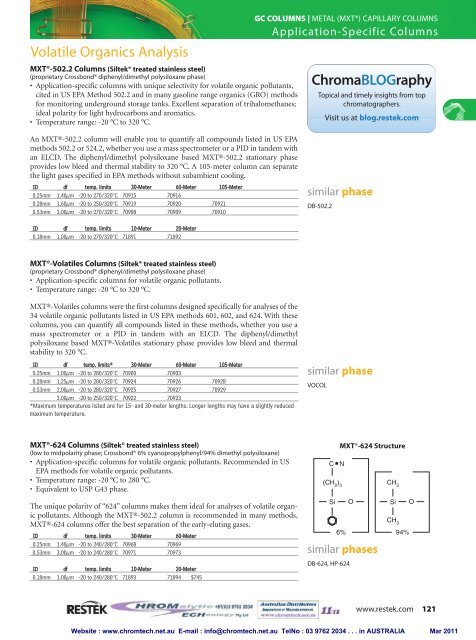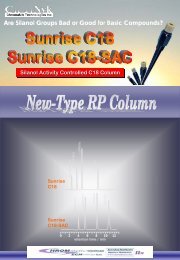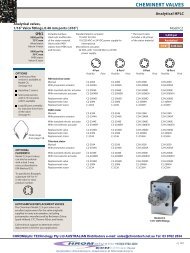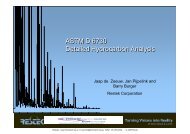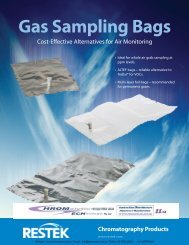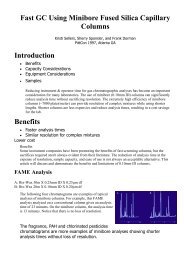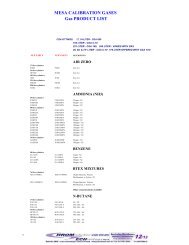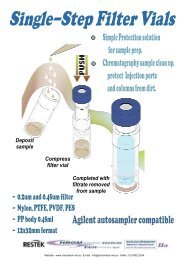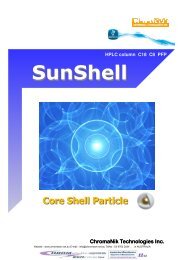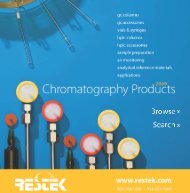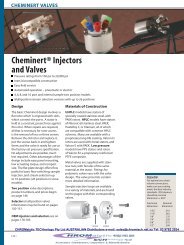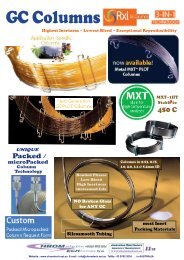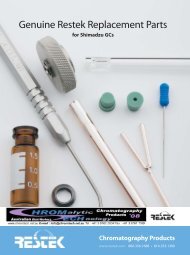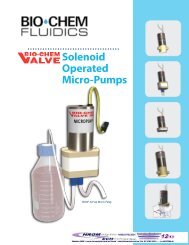gc columns
gc columns
gc columns
- No tags were found...
Create successful ePaper yourself
Turn your PDF publications into a flip-book with our unique Google optimized e-Paper software.
Volatile Organics AnalysisMXT®-502.2 Columns (Siltek® treated stainless steel)(proprietary Crossbond® diphenyl/dimethyl polysiloxane phase)• Application-specific <strong>columns</strong> with unique selectivity for volatile organic pollutants,cited in US EPA Method 502.2 and in many gasoline range organics (GRO) methodsfor monitoring underground storage tanks. Excellent separation of trihalomethanes;ideal polarity for light hydrocarbons and aromatics.• Temperature range: -20 °C to 320 °C.GC COLUMNS | METAL (MXT®) CAPILLARY COLUMNSApplication-Specific ColumnsChromaBLOGraphyTopical and timely insights from topchromatographers.Visit us at blog.restek.comAn MXT®-502.2 column will enable you to quantify all compounds listed in US EPAmethods 502.2 or 524.2, whether you use a mass spectrometer or a PID in tandem withan ELCD. The diphenyl/dimethyl polysiloxane based MXT®-502.2 stationary phaseprovides low bleed and thermal stability to 320 °C. A 105-meter column can separatethe light gases specified in EPA methods without subambient cooling.ID df temp. limits 30-Meter 60-Meter 105-Meter0.25mm 1.40µm -20 to 270/320°C 70915 709160.28mm 1.60µm -20 to 250/320°C 70919 70920 709210.53mm 3.00µm -20 to 270/320°C 70908 70909 70910similar phaseDB-502.2ID df temp. limits 10-Meter 20-Meter0.18mm 1.00µm -20 to 270/320°C 71891 71892MXT®-Volatiles Columns (Siltek® treated stainless steel)(proprietary Crossbond® diphenyl/dimethyl polysiloxane phase)• Application-specific <strong>columns</strong> for volatile organic pollutants.• Temperature range: -20 °C to 320 °C.MXT®-Volatiles <strong>columns</strong> were the first <strong>columns</strong> designed specifically for analyses of the34 volatile organic pollutants listed in US EPA methods 601, 602, and 624. With these<strong>columns</strong>, you can quantify all compounds listed in these methods, whether you use amass spectrometer or a PID in tandem with an ELCD. The diphenyl/dimethylpolysiloxane based MXT®-Volatiles stationary phase provides low bleed and thermalstability to 320 °C.ID df temp. limits* 30-Meter 60-Meter 105-Meter0.25mm 1.00µm -20 to 280/320°C 70900 709030.28mm 1.25µm -20 to 280/320°C 70924 70926 709280.53mm 2.00µm -20 to 280/320°C 70925 70927 709293.00µm -20 to 250/320°C 70922 70923*Maximum temperatures listed are for 15- and 30-meter lengths. Longer lengths may have a slightly reducedmaximum temperature.similar phaseVOCOLMXT®-624 Columns (Siltek® treated stainless steel)(low to midpolarity phase; Crossbond® 6% cyanopropylphenyl/94% dimethyl polysiloxane)• Application-specific <strong>columns</strong> for volatile organic pollutants. Recommended in USEPA methods for volatile organic pollutants.• Temperature range: -20 °C to 280 °C.• Equivalent to USP G43 phase.The unique polarity of “624” <strong>columns</strong> makes them ideal for analyses of volatile organicpollutants. Although the MXT®-502.2 column is recommended in many methods,MXT®-624 <strong>columns</strong> offer the best separation of the early-eluting gases.ID df temp. limits 30-Meter 60-Meter0.25mm 1.40µm -20 to 240/280°C 70968 709690.53mm 3.00µm -20 to 240/280°C 70971 70973ID df temp. limits 10-Meter 20-Meter0.18mm 1.00µm -20 to 240/280°C 71893 71894 $745MXT®-624 StructureC N(CH 2) 3CH 3Si OSi OCH 36%94%similar phasesDB-624, HP-624www.restek.com 121Website : www.chromtech.net.au E-mail : info@chromtech.net.au TelNo : 03 9762 2034 . . . in AUSTRALIA Mar 2011


